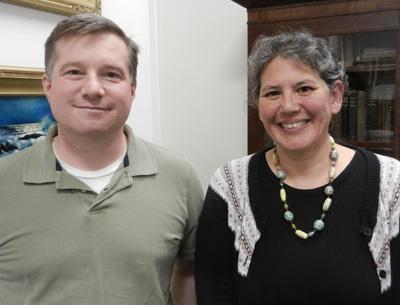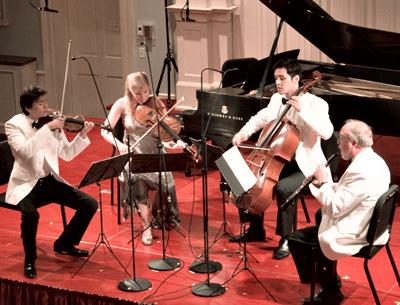The Art Scene: 05.30.13
The Art Scene: 05.30.13

East End Photogs at 25
The East End Photographers Group will observe its 25th anniversary with a show at Ashawagh Hall in Springs opening Saturday and running through June 9. This will be the first of a number of shows in the area this season to mark the milestone. The group has dedicated this one to the memory of Tim Lee and Vito Sisti, who both died this year.
As one of the founding members, Mr. Lee offered his studio to Liz Glasgow and other Springs photographers to share and talk about their work. They organized their first exhibition at Ashawagh Hall in April 1990. Since then, the members have observed the tradition of a spring show.
The group grew from those first years to other places such as Southampton and the North Fork, and also splintered off into another group, Photographers East, which is primarily made up of Southampton-based photographers.
The group’s members use a variety of formats such as traditional, digital, and alternative processes. Those exhibiting for this show include Virginia Aschmoneit, Dennis Bontempo, Ann Brandeis, David Burns, Zintis Buzermanis, Anne Drager, Paul Dempsey, Rich Faron, Alex Ferrone, Ray Germann, Janet Glazer, Gerry Giliberti, Pamela Greinke, Elizabeth Holmes, Danielle Leef, Joel Lefkowitz, George Mallis, Jim Sabiston, Joan Santos, Rosa Hanna Scott, Daniel Schoenheimer, James Slezak, Marilyn Stevenson, Jarret Stretch, Clarence Simpson, Nick Tarr, Mary Trentalange, Bob Wilson, Nacola Wilson, Alan Weinschel, and Mia Wisnoski.
The opening reception will be held on Saturday from 5 to 9 p.m. There will also be a closing reception on June 9 from 3 to 5 p.m.
A Whale of a Show
Peter Marcelle and Dan Rizzie have taken over the Sag Harbor Whaling and Historical Museum for “A Whale of a Show.” The group exhibition features Derek Buckner, April Gornik, and Reynold Ruffins. Other artists with work on view include Paul Davis, Eric Dever, Miriam Dougenis, Eric Fischl, Susan Lazarus Reimen, Jim McMullen, Jodi Pana, Dan Rizzie, Gavin Zeigler, David Slater, Donald Sultan, John Torreano, and Carol York.
The show will be on view through June 25.
Blue Star at Parrish
The Parrish Art Museum in Water Mill is participating in the Blue Star Museums collaboration with the National Endowment for the Arts, Blue Star Families, the Department of Defense, and various national museums this summer. The program offers free admission to all active-duty military personnel and their families from Memorial Day through Labor Day.
“Soul Searching” at Lear
Ronald Gonzalez, a sculptor, will be the next featured artist at Lear Gallery in Sag Harbor. In a show titled “Soul Searching,” he will offer 60 prototypes and studies of life-size figures in scaled-down versions. The abstracted figures are composed of found objects and his own thin armatures.
The show will open Saturday with a reception from 5 to 7 p.m. and close on July 14.
“Tone Poem” at Halsey Mckay
Halsey Mckay Gallery in East Hampton will have “Tone Poem,” a group show, beginning Saturday. It features N. Dash, Elias Hansen, Matt Kenny, Rosy Keyser, and Adam Marnie.
Each of the artists employs humble and common materials to come up with different possibilities and compositions. Abraided wood, marked wallboard, plastic bags, sawdust, and adobe are some of the mediums transformed by their processes. According to the gallery, “An undercurrent of inventiveness, economy of means, and commitment to hands-on approaches shines through” in this work. Often, a thing is not what it appears to be, and nothing is as simple as it seems.
The show opens Saturday with a reception from 6 to 8 p.m. It will close on June 18.
Tough Girls
Neoteric Fine Art will present “Bad Ass Bitches,” an all-female show organized by Melissa Mapes, starting tomorrow in Amagansett.
Ms. Mapes describes the show as featuring a group of women with “raw talent, no fear, and a rebel passion to do what they love.” Among the artists with work on view are Melissa Armstrong, Abby Lloyd, Christine Lidrbauch, Christine Sciulli, Geige Silver, Graylen Gatewood, Maria Pessino, Elyse Hradecky, Jackie Guido, Andrea Cote, Nika Nesgoda, Marsha Owett, Matisse Patterson, Robin Mapes Tomlinson, and Ms. Mapes herself.
They work in various mediums including painting, sculpture, photography, collage, performance, video art, and music. A percentage of proceeds from the exhibition will be donated to the Retreat and Long Island Head Start, two local organizations serving women in need.
An opening reception for the artists will be held tomorrow from 6 p.m. to midnight with a musical performance by Spittin’ Kitten, a theatrical performance by the Neo-Political Cowgirls, poetry by Denise Lassaw, and dancing by the Fiery Sensations. A late-night dance party with D.J. Alanna Raben will follow. Admission is $10.
“Creative Vision,” Open Call
The gallery at the Water Mill Museum will show “Creative Vision: Works by East End Artists” this weekend with a reception on Saturday from 4 to 7 p.m.
The show features 18 women artists who work in different styles and materials such as oil, pastel, watercolor, acrylics, glass, textiles, photography, and metal sculpture. Susan D’Alessio, Anna Franklin, Phyllis Hammond, Kathie Hayden, Annette Heller, Tracy Jamar, Cyndi Loewen, Jean Mahoney, Lynn Martel, Mary Milne, Deb Palmer, Roxanne Panero, Alyce Peifer, Christine Chew Smith, Cynthia Sobel, Lieve Thiers, Claudia Ward, and Pam Vossen will offer representational landscapes and figurative, abstract, and conceptual art.
The museum will hold its annual members art exhibition from June 20 to July 8 and is now accepting registration forms for this non-juried show. Artists in all mediums have been invited to apply. Forms are available on the museum’s Web site, and the deadline is June 8.
Marilyn Church’s Burton Award
Marilyn Church will be the recipient of an award naming her the “foremost courtroom artist in America” as part of the Burton Awards to be presented by the Library of Congress on Monday. She has been commissioned to do a portrait of Supreme Court Justice Sonia Sotomayor, a fellow award recipient, and her work will be on view at the event.
Ms. Church’s work is also on view at Toulouse Interiors in Asbury Park, N.J., where there will be a reception on Saturday from 6 to 10 p.m.
Water, Water, Everywhere
Tulla Booth Gallery in Sag Harbor will show “Water 2013” beginning Saturday with a reception from 6 to 8 p.m. The show will feature classic and contemporary photography with the theme of the sea. Those with work on view include Blair Seagram, Herb Friedman, Anne Gabrielle, Karine Laval, Tulla Booth, Bob Tabor, and Michael Clinton. It will remain on view through June 25.
Reit and Rotner Do the Monkey
The Crazy Monkey Gallery in Amagansett will feature the art of two of its members, Stephanie Reit and Sheila Rotner, as well as a group exhibit of the art cooperative’s members in a show that will open today with a reception Saturday from 5 to 7 p.m.
Also with work on view will be Andrea McCafferty, Daniel Schoenheimer, Jana Hayden, Barbara Bilotta, June Kaplan, Ellyn Tucker, Mark E. Zammerman, Tina Andrews, Lance Corey, Cynthia Sobel, Dianne Marxe, Kathy Hammond, and Daniel Dubinsky. The show will be up through June 24.
Fore!
The Bridgehampton Museum will open “From Pastures to Putting” tomorrow at 5 p.m. with a reception until 7. The show will follow the development of golf in greater Bridgehampton and the history of the associated clubs in the area. Objects on display will include original equipment and fashions in pictures and on mannequins. Julie Greene, the museum’s archivist, has organized the show.
Hoie at Clinton Academy
Claus Hoie’s watercolors will be featured in a show at Clinton Academy in East Hampton called “Insects: Real and Imaginary,” opening Saturday. The exhibition is a survey of three decades of work focused on this subject, some from his final years. Hoie, who died in 2007, has several paintings from his whaling series on view at the East Hampton Town Marine Museum in Amagansett.
He is familiar to many here for his paintings of vessels, 19th-century captains’ logs, fish, and themes from “Moby-Dick.” He also painted historic structures in East Hampton Village. The show will remain up through June 30.
Desire at Demato
The Richard J. Demato Gallery in Sag Harbor will show “Objects of Desire” beginning Saturday with a reception from 6 to 8 p.m. The show is designed to stimulate emotional and introspective responses. The art has been chosen to activate parts of the brain that respond with “emotion, thought, memories, perceptual awareness, motivation, and stream of consciousness.”
At the opening reception, music, lighting, scents, and a full bar will help enhance the experience.
Markel’s Season Opener
“Everything Has Its Place” is the season opener at Kathryn Markel Fine Arts in Bridgehampton. The show has been organized by Robert Dimin, who has chosen a number of emerging New York artists from various disciplines. Nick Doyle, Justine Hill, Bradley LaMare, Corey Riddell, Dana Sherwood, and Bryan McGovern Wilson are all participants.
They work in sculpture, painting, charcoal and pencil drawing, photography, and other more unorthodox mediums, each approaching them in an unconventional way. Ms. Sherwood, for example, uses methodologies that sometimes involve organic materials and elaborate confectionery as well as interventions by animals in her sculptural installations. Mr. Wilson combines photography, drawing, and all facets of sculpture, like glasswork and assemblage, in his detail-oriented installation spaces.
The exhibition opens Saturday with a reception from 6 to 9 p.m. It will close on June 19.
Business of Art Returns
Jane Martin is offering her popular series of classes for artists on the business of art at the Springs Presbyterian Church beginning Saturday with one called “The Professional Artist.”
To be held from 10:30 a.m. to 12:30 p.m., it will cover consignments and contracts with galleries, invoicing clients, and eliminating tax on art supplies with a resale certificate. Other topics include how to legally protect your art and your relationships with galleries and how to provide a professional invoice for sales out-of-studio.
The cost of $40 per class includes numerous handouts and guest speakers. Payment can be made at the door with cash or check. Checks received by the Wednesday before a class will receive a $5 discount. Ms. Martin’s e-mail for further information is janemartin@mac. com. Checks can be sent to Ms. Martin at P.O. Box 471, East Hampton 11937.



